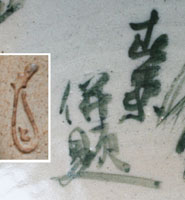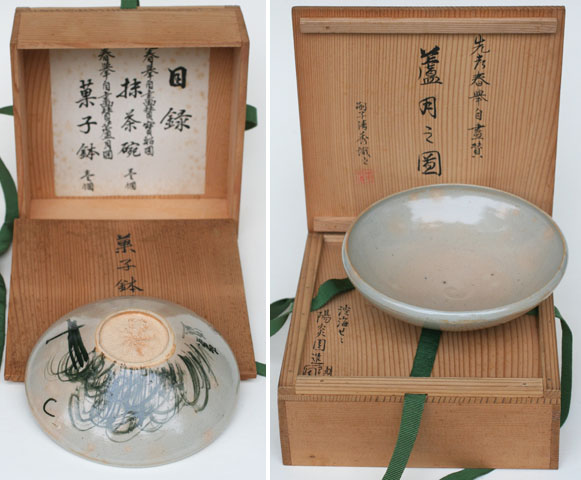Nhonga and Zeze
Kashibachi, cake bowl - Flowering reeds in deep places with a very round moonSigned: Shunkyo heidai
Seals: Zeze
Technique: Wheel turned translucent grey glazed gohonde Zezeyaki, earthenware from Ôtsu, with a tetsu-e, iron oxide underglaze decoration. Ø 18 x 5,7
Box: Signed by the potter (bottom) and authorized by his son Kiyohide
Condition: fine
Shunkyo was born in Shiga prefecture. He studied painting with Nomura Bunkyo (1854-1911), but after Bunkyo moved to Tokyo in 1885, Shunkyo became a pupil of Mori Kansai (1814-1894). Together with Tsuji Kakô (1870-1931) he worked at Takashimaya department store where they created designs for export textiles. He studied photography and yoga (western-style oil painting). After 1900 he became one of the most successful Nihonga artists in Kyoto and his juku (private school) was as popular as that of Takeuchi Seihô (1864-1942). After his return to Shiga, his house and studio near Lake Biwa were located next-door to the Zezeyaki kiln, which he helped revive.
Reference:
Kyôto 1982
Shiga 1985
Shiga 2000
Berry & Morioka ‘99 pp. 126-127
Conant pp. 330-331
Roberts p. 196
Iwasaki Kenzô was the potter who initiated Zezeyaki in Ôtsu, on Lake Biwa. At the beginning of 1919 Kenzô reestablished the Kagero-en kiln. In reviving Zeze tea ceramics in the traditional style, Kenzô had the support of local artists, such as Yamamoto Shunkyo and the potters Itô Tozan I (1846-1920) and Tozan II (1871-1937).
Reference:
Crueger 2004, p. 149
Price: ON REQUEST

